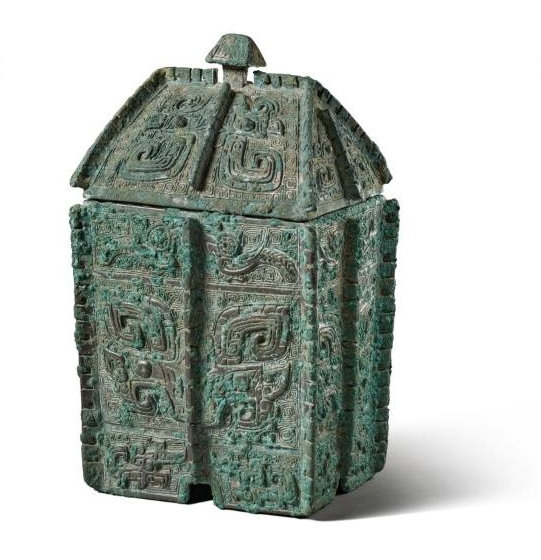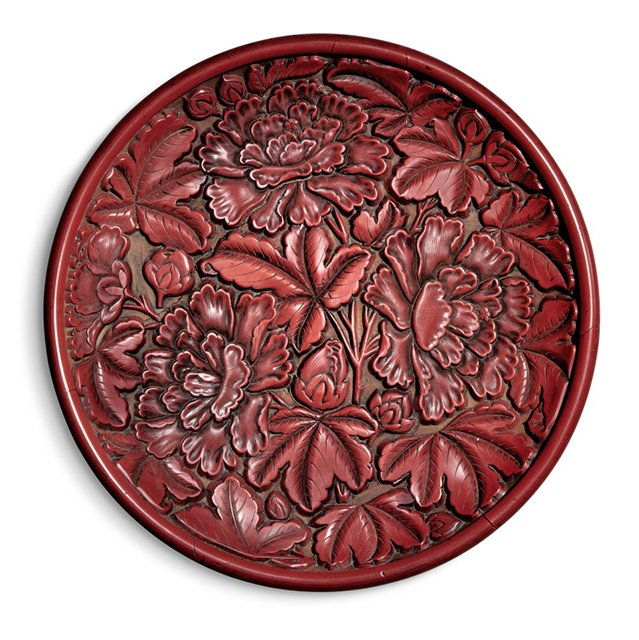Sotheby's to auction $40M+ Dr. Wou Kiuan Collection
NEW YORK, NY.- Coinciding with the return of New York Asia Week this March, Sotheby’s will present the first of a series of four single-owner sales to held globally throughout 2022 from one of the last great collections of Chinese art remaining in private hands, The Dr Wou Kiuan Collection. Celebrating 4,000 years of Chinese culture and art history, the Dr Wou Kiuan Collection spans pottery, porcelain, jades, bronzes, paintings, calligraphy and more, the extraordinary scope of the collection sets it apart from all other private collections of Chinese art formed in the mid-20th century.
Estimated to achieve in excess of $40 million and featuring more than 1,000 works, the collection together represents a comprehensive visual history of China, ranging from utilitarian storage vessels made by the first Neolithic cultures that emerged along the Yellow River to the most dazzling porcelains ever commissioned to adorn the palaces of the Qing Emperors of China’s final dynasty.
Driven by a desire to promote Chinese art and culture and preserve the relics of China’s rich historical past, Wou created a private gallery in 1968 located in the ground floor of his home to present the collection, which has housed the works for over five decades.
The collection is highlighted by a highly important and magnificently carved soapstone seal carved for the Qianlong emperor early in his reign, on offer in a dedicated auction this April in Hong Kong. Found prominently impressed on countless important Chinese paintings including the two most revered classical masterpieces in the world, no other imperial seal to have come to market appears on such a large number of historically important paintings.
On offer in a dedicated auction on 22 March in New York titled A Journey Through China's History: The Dr Wou Kiuan Collection Part I, additional objects from the Wou Collection will be offered in dedicated auctions in Hong Kong and London throughout 2022.
Public exhibitions of Sotheby’s Asia Week auctions will open on 17 March in our New York galleries.
Angela McAteer, Head of Sotheby’s Chinese Works of Art Department in New York, commented: “We’re thrilled to kick off the return of our March Asia Week sales with the single-owner auction of the renowned Dr. Wou Kiuan Collection. Among the most comprehensive collections of Chinese Art ever assembled, the 130 works emerging in the New York auction from this extraordinary collection represent the finest examples of virtually every category of Chinese art, ranging from pottery to porcelains, jades, bronzes and more. From utilitarian storage vessels to Imperial treasures, each work of art is a story of Chinese history to be discovered."
WOU KIUAN
The uniquely comprehensive collection was formed by Wou Kiuan, son of Wou Lien-Pai (Wu Jinglian, Wu Lianbo), a prominent politician instrumental in the reformation of China during the Republic period. A collector in the truest sense, Wou Kiuan collected stamps and books before turning his attention to Chinese art. Upon settling in London after his retirement, Wou devoted his time to the study of Chinese archaeology and art, and rigorously researched each work that entered his collection. He developed a close friendship with Cambridge-based scholar of Chinese art and archaeology Professor Cheng Te-K’un, who was instrumental in nurturing Wou’s passion for Chinese art and who guided him in his early collecting journey.
Wou’s years of collecting fortuitously coincided with an abundant availability of exceptional Chinese art on the London market. From the mid-1950s to late 60s, Wou formed a collection of well over 1,000 works that together represented every category of Chinese art. Wou acquired works from sales of some of the most prominent collectors of the early 20th century including Sir Percival David, Brenda Zara Seligman, and Henry Knight, as well as Alfred Morrison, whose legendary collection of ‘Fonthill Treasures’ included some of the most important porcelains and enamels to have been produced for the Qing Emperors of the 18th and 19th centuries. In the 1965 and 1971 auctions of works from the Fonthill Collection, Wou acquired no less than five Imperial treasures, which rank amongst the most important works in the collection.
His early foray into the world of Chinese art collecting focused on archaic bronzes and other works of historical significance. As one of the very few Chinese collectors active in the salerooms at the time, Wou had the distinct advantage of being able to read the inscriptions found on some important bronzes, jades and sculptures. As a result, the collection is particularly rich in epigraphical works.
In 1968, Wou created a private gallery in his home titled the Wou Lien-Pai Museum, named in honor of his father. Located in a discreet corner of the southern British Isles, the Museum became a destination for collectors, academics, and visiting dignitaries, and Wou would delight in leading his visitors through the galleries, recounting stories of China’s glorious history. To this day, the Wou family has remained a conscientious custodian of the collection, loaning works to exhibitions and publishing a two-volume catalogue in 2011, thus continuing to educate future generations.
COLLECTION HIGHLIGHTS
HIGHLY IMPORTANT AND MAGNIFICENTLY CARVED SOAPSTONE SEAL CARVED FOR THE QIANLONG EMPEROR
Single-Lot Auction
Hong Kong – April 2022
Estimate Upon Request
Masterpieces of Qing porcelain and works of art will be offered in Hong Kong throughout 2022, including an important group of enamelled porcelains formerly in the Fonthill heirlooms. The Hong Kong chapter of the Wou Collection will kick off in April with a highly important and magnificently carved soapstone seal carved for the Qianlong emperor early in his reign, which bears the inscription Qianlong Yulan Zhibao (admired by his Majesty the Qianlong Emperor). The seal is found prominently impressed on countless important Chinese paintings including the two most revered classical masterpieces in the world, namely Fan Kuan’s Travellers. Among Mountains and Streams and Guo Xi’s Early Spring, both dating from the Northern Song Dynasty. No other imperial seal to have come to market appears on such a large number of historically important paintings.
A Rare Archaic Bronze Rectangular Vessel (Fangyi), Late Shang dynasty, Anyang, 12th century BC. Estimate $400,000-600,000. Lot sold: 882,000 USD. Courtesy Sotheby's.
In form and design, the present fang yi represents Chinese bronze art at its height, when the Anyang style had reached its mature phase. Only a small number of further fang yi with related decoration, featuring birds below the rim and slight variations in design have been recorded, with others residing in prominent institutions such as the Shanghai Museum; and a fang yi in the British Museum from the Sedgwick Collection. The closest comparisons to the present example come from the tomb of Fu Hao, the only undisturbed Shang royal tomb discovered at Yinxu, the site of the late Shang capital in Anyang, Henan. Fu Hao was not only a consort of King Wu Ding, but a remarkable woman in her own right, serving as a military leader in several campaigns and probably also fulfilling the roles of a priestess. Dating from around 1200 BC, her tomb was generously furnished with exceptionally fine and rare bronzes.
Vessels of fang yi type have been variously interpreted as containers for food or wine, and could certainly have served for either function, however, are now generally considered to have been wine vessels.
A Large and Important Imperially-Inscribed Pale Green Jade 'Luohan' Boulder, Qing dynasty, Qianlong period (1736-1795). Estimate $400,000-600,000. Courtesy Sotheby's.
This jade boulder is remarkable for its exceptional carving of the luohan dramatically set against the backdrop of a rough stone grotto, its large overall size, and its imperial inscription. It represents a three-dimensional, sculptural version of a late Tang (618-907) painting which had particularly impressed the Qianlong Emperor. In 1757, the Qianlong Emperor visited the Shengyin Temple in Hangzhou, Zhejiang, where he saw a set of paintings depicting the Sixteen Luohan by the painter Guanxiu - a Chan monk famous for his paintings of Buddhist figures, which are known today mainly through later copies (832-912). He recorded that he had seen himself the masterpieces of Guanxiu and, as a devotee of Buddhism, studied their content and reordered and reattributed the paintings according to his own teacher’s interpretation of their sequence. He penned colophons on each painting and commissioned reproductions of the images with their new inscriptions in various media, including stone engravings, jade carvings and textiles. The Shengyin Temple was destroyed and the original set of Guanxiu’s Luohan paintings appears to be lost. However, we can assume that their basic style is preserved in the engravings commissioned by the Qianlong Emperor.
A Magnificent Carved Cinnabar Lacquer 'Hibiscus' Dish, Yuan-Early Ming dynasty, 14th century. Estimate $100,000-150,000. Courtesy Sotheby's.
Appearing at auction for the first time in more than five decades, this large and exquisitely carved cinnabar lacquer dish appears to be unique, and no other dish with this design appears to be recorded. Stylistically, it can be placed into the peak period of Chinese lacquer craftsmanship, in the late Yuan (1279-1368) to early Ming dynasty (1368-1644). The decoration is unusual in being limited to three blooms among foliage, a design more typically seen on much smaller dishes and boxes. The ample size of the present dish allowed the flowers to be rendered in magnificent large scale. Although hibiscus is popular in China, the flower is surprisingly rarely depicted in Chinese art. On the present dish, the depiction of the hibiscus flowers includes a charming naturalistic detail hardly otherwise ever captured in artistic renderings of the motif: all three blooms show a tiny five-pointed ‘floret’ protruding from the petal tips, representing the stigma that receives the pollen in the centre of the bloom. The carving style is remarkable for its boldness, clear layout, overall soft, well-polished finish, and smooth, rounded outlines of the various elements of the flowers.

/https%3A%2F%2Fprofilepics.canalblog.com%2Fprofilepics%2F1%2F0%2F100183.jpg)
/https%3A%2F%2Fstorage.canalblog.com%2F03%2F02%2F119589%2F96711876_o.jpg)
/https%3A%2F%2Fstorage.canalblog.com%2F11%2F31%2F119589%2F94773502_o.jpg)
/https%3A%2F%2Fstorage.canalblog.com%2F20%2F83%2F119589%2F94772815_o.jpg)
/https%3A%2F%2Fstorage.canalblog.com%2F26%2F72%2F119589%2F75604929_o.jpg)
/https%3A%2F%2Fstorage.canalblog.com%2F59%2F60%2F119589%2F26458628_o.jpg)






/image%2F1371349%2F20240425%2Fob_c453b7_439605604-1657274835042529-47869416345.jpg)
/image%2F1371349%2F20240425%2Fob_59c6f0_440358655-1657722021664477-71089985267.jpg)
/image%2F1371349%2F20240425%2Fob_07a28e_440353390-1657720444997968-29046181244.jpg)
/image%2F1371349%2F20240425%2Fob_0b83fb_440387817-1657715464998466-20094023921.jpg)